- Home
- Publications and statistics
- Publications
- Monthly Business Survey – Start of June ...
The Banque de France publishes a range of monthly and quarterly economic surveys that provide a snapshot of the French economy in the form of business climate indicators and short-term forecasts.
According to the business leaders surveyed (around 8,500 companies and establishments questioned between 26 May and 5 June), activity rose slightly in May in industry and services, and fell back in construction. For June, business leaders expect activity to edge up in industry, and post a slightly more marked rise in services and construction.
Supply difficulties continued to ease in construction (15% of companies reported difficulties in May, after 17% in April) and in industry (23% of companies reported difficulties, after 28% in April). For the second month in a row, manufacturers indicated a sharp fall in raw material prices and a levelling‑off of finished products prices. For the first time, service prices ceased to rise, while construction prices continued to slow. Recruitment difficulties posted a further decline, but still affected almost half of all companies (49%).
Our uncertainty indicator decreased slightly in industry and construction, and a little more markedly in services. However, it was still high compared with pre‑2020 levels. In industry, order books shrank again. Cash positions stabilised in industry and declined in services.
Based on the survey results, as well as other indicators, we estimate that GDP growth in the second quarter of 2023 should be 0.1% higher than in the previous quarter.
1. In May, activity edged up in industry and services, but dropped in construction
In May, activity rose slightly in industry, while companies were expecting a fall at the beginning of last month. Balances of opinion indicate that production increased in the agri‑food, automotive and IT, electronic and optical products sectors. The latter sectors in particular benefited from a recovery in activity linked to the less severe shortages of electronic components. Conversely, activity was down in metal and metal products manufacturing and pharmaceuticals; wood, paper and printing and wearing apparel, textiles and footwear were also down, with business leaders pointing to a wait‑and‑see attitude on the part of customers due to the economic situation and a lower purchasing power.
The succession of shocks since the start of 2022 has particularly affected certain sectors, where activity has dropped markedly over the past 18 months. While the capacity utilisation rate has remained stable overall in the manufacturing industry (77% in May 2023, after 79% in January 2022, i.e. a fall of 2 points), some sectors have posted sharper declines: wood, paper and printing (down 8 points), rubber and plastic products (down 7 points), wearing apparel, textiles, footwear and chemicals (down 6 points).

In May, inventories of finished goods rose again slightly across most sectors, due to lower customer demand. However, inventories fell in the automotive industry as a result of an increase in deliveries, linked in particular to a less severe shortage of drivers.
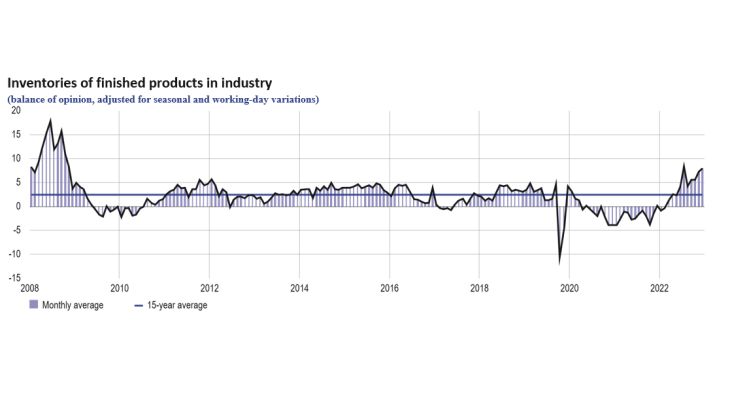
In market services, activity increased slightly. It improved in accommodation, publishing, management consultancy, transport and personal services. Conversely, activity contracted in advertising and market research, as well as in car repairs.
Activity dipped in construction, with a significant drop in structural works and little change in finishing works. This drop in construction activity – particularly in new construction – is beginning to affect construction‑related industrial sectors such as rubber and plastic products and electrical equipment.
The balance of opinion on cash positions stabilised in industry, due to the continued easing of energy and raw material prices; however, it remained below its long‑term average. In May, cash positions fell sharply in services; they were well below their long‑term average in most business services (legal and accounting activities, information services).
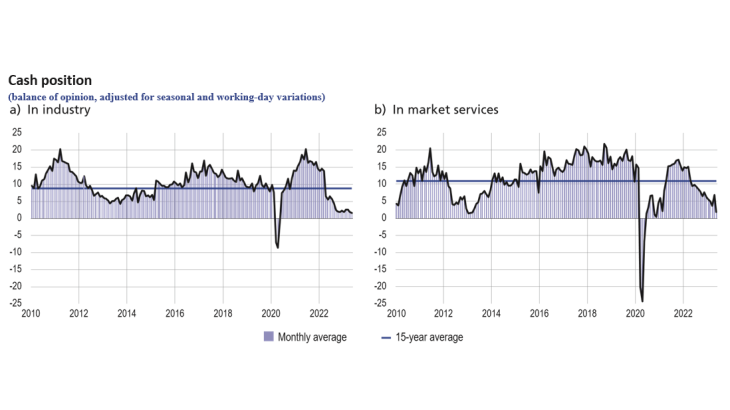
2. In June, business leaders expect activity to increase slightly in industry, and more markedly in services and construction
In June, business leaders in industry expect activity to improve slightly overall. Activity is expected to rise in the automotive, aeronautics and computer, electronic and optical products sectors, but to drop further in chemicals and rubber and plastic products.
In services, activity is expected to grow more strongly. Business leaders expect activity to rise in the accommodation sector and, to a lesser extent, in business services.
Lastly, in construction, business leaders expect activity to rise, in particular in finishing work.
Our monthly uncertainty indicator, which is constructed from a textual analysis of comments made by the respondent companies, points to an easing in the three large sectors with a slightly more marked decrease in services. However, it remained above its pre‑Covid average level.

In industry, the balance of opinion on order books fell again, with the business leaders surveyed pointing to a rise in competition from Asia in some sectors, such as chemicals, and machinery and equipment. It was below its 15‑year average, albeit with a strong polarisation between sectors where order books were deemed to be well‑stocked (automotive, aeronautics, computer products) and those where order books are deemed to be low (agri‑food, chemicals, wood, paper and printing, rubber and plastic products). In construction, order books hardly changed, hovering around their long‑term average. Since mid‑2022, the deterioration in order books in construction has been exclusively attributable to structural works, which suffered from the sharp drop in sales of new single‑family homes; order books for finishing works, on the other hand, have been stable for nine months, in line with energy renovation activity.
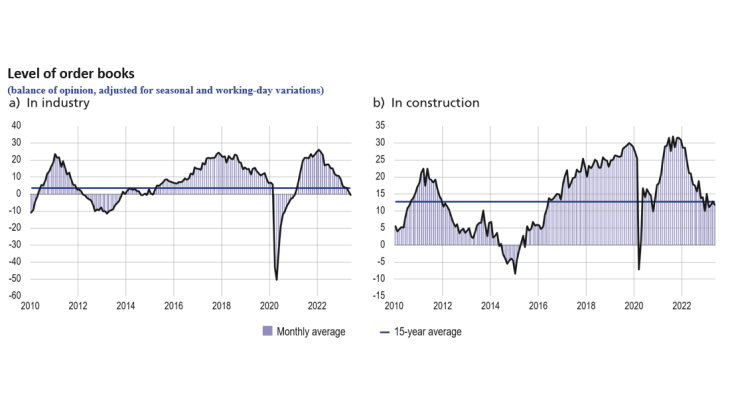
3. Supply difficulties continued to subside; the pace of price increases slowed sharply in all sectors
In May, supply difficulties continued to diminish in industry (affecting 23% of businesses, after 28% in April) and in construction (15%, after 17%).
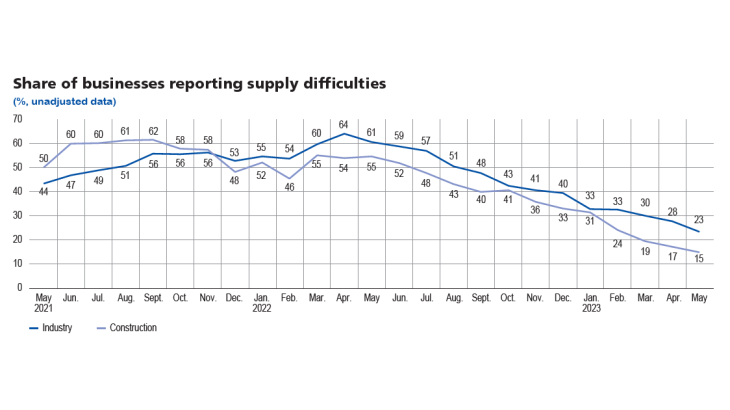
The balance of opinion on raw material prices pointed to a further fall in industry. The balance of opinion on finished products prices in industry hardly changed in May, confirming a return to a pace of price increases comparable to that of the pre‑Covid period. However, because of the production process – in particular higher input prices and rising wages – business leaders indicated that they were unable to pass on the fall in raw material prices to selling prices (chemicals, pharmaceuticals, machinery and equipment). In construction, prices slowed again. In services, the slowdown in prices intensified in May, and the balance of opinion was again close to its pre‑Covid level.
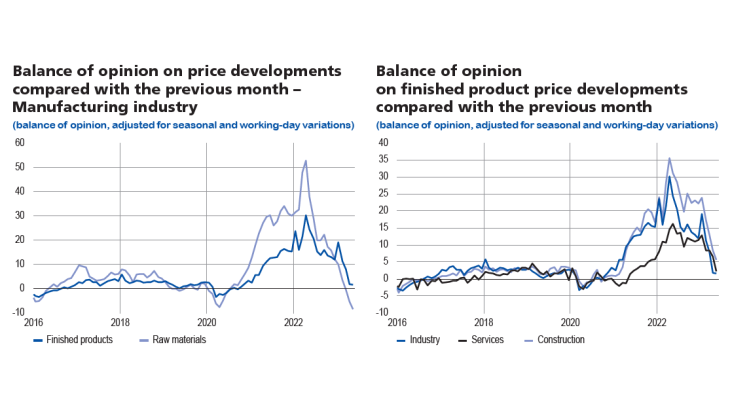
More specifically, 10% of business leaders said they raised their selling prices in industry in May, i.e. a level close to the expectations they expressed last month (9%) and to the pre‑Covid level; in agri‑food, this proportion reached 13% (compared with 20% in May). In addition, 5% of business leaders in the manufacturing sector said they lowered their selling prices in May, in line with the easing of raw material prices. This fall in input prices was significant in most sectors, particularly in chemicals, wood, paper and printing, and to a lesser extent in wearing apparel, textiles and footwear and agri‑food, where more than 20% of business leaders reported a fall in raw material prices in May.
In construction, 15% of business leaders raised their prices in May (after 23% in April). In services, the proportion fell to 12% (after 19%), its lowest level since the end of 2021. The overall outlook for June suggests further easing in industry (9%), market services (10%) and construction (14%).

Business leaders were also asked about their recruitment difficulties. These difficulties fell slightly in May, and concerned 49% of the businesses questioned in all sectors.

4. Our estimates point to a 0.1% increase in GDP in the second quarter
For the month of May, the use of survey information at a fine level of disaggregation, as well as other available data, leads us to estimate that GDP is expected to rise slightly compared to April. Value added should be up slightly in industry and market services, and down slightly in construction.
More specifically, according to the survey data, value added is expected to rise in manufacturing and in the agri‑food industry. Value added in the services covered by the survey is expected to increase in May, both in household services and in accommodation and food services. It is expected to be stable in business services. Finally, construction is expected to contract slightly in May.
The high‑frequency data that we monitor in parallel for those service sectors excluded from or only partially covered by the survey suggest that value added increased moderately in the trade sector and more markedly in transport services. After rebounding in April, the energy sector (not covered by the survey) continued to grow.

Business leaders’ forecasts for June indicate that GDP will rise slightly compared with May, with again contrasting performances across sectors. For the second quarter of 2023 as a whole, we estimate that GDP will rise by 0.1% on the previous quarter.
Download the PDF version of this article
Updated on 7 December 2023